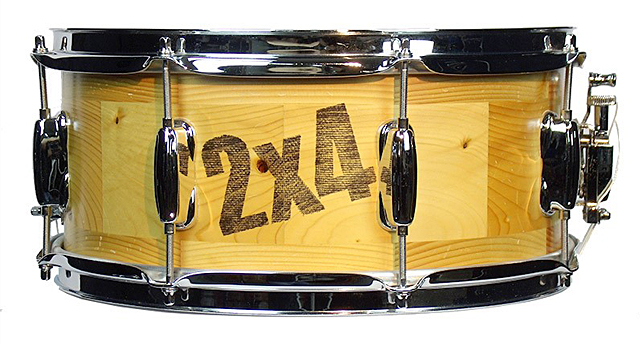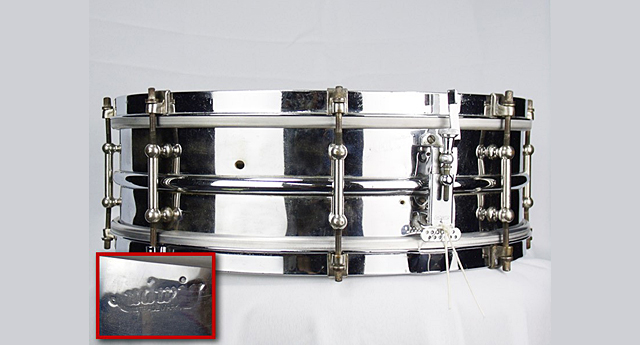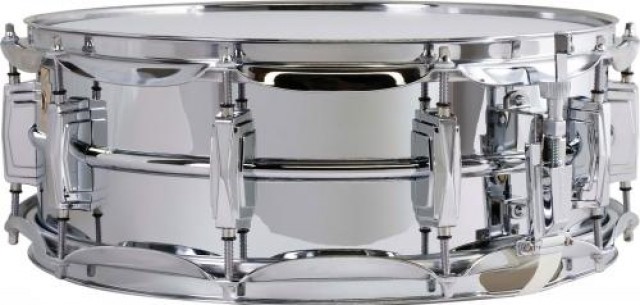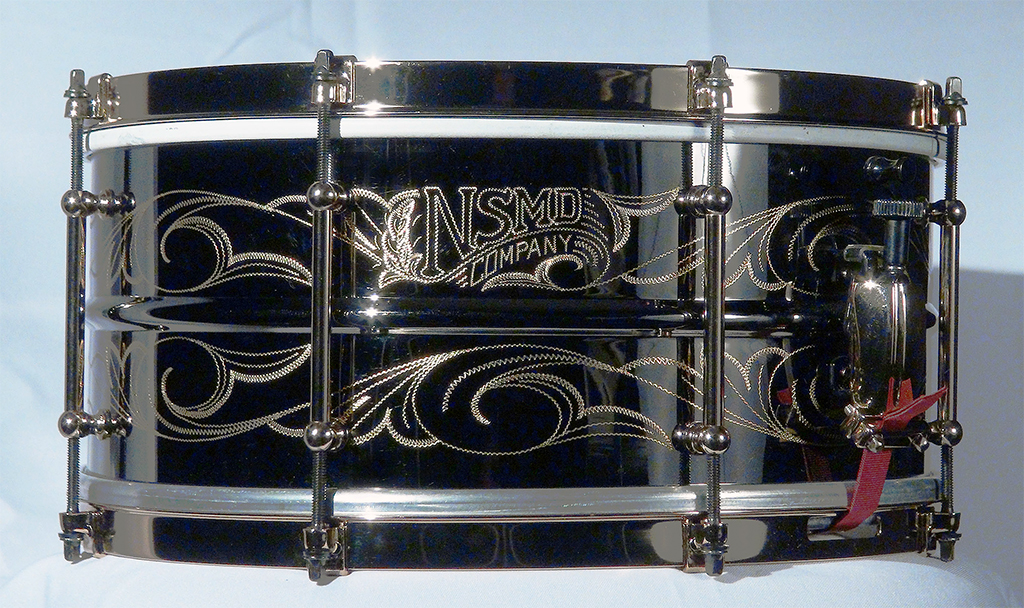I was reading some posts online & George mentioned that you folks found a lacquer that was hard enough to topcoat cymbals. Could you tell me what that lacquer is or can I buy some from you folks for my Paiste Signature Series fast crash? - Stan
Read moreSilver Badge Supraphonic prototype controversy?
"The Ludwig engineering group used the silver hand scribed badges whenever they were prototyping a new design, or were interested in tracking a particular drum. I personally saw an all aluminum Acrolyte set which used the silver hand scribed badges which never made it to the production line and was never offered for sale. It had an Acrolyte snare with a silver hand scribed badge.
Read moreFamous 2x4 Snare Drum
Drum Stats
Famous Drum Company
5.5" x 14"
"2x4" snare drum - block shell construction made from spruce two by four lumber
Joe Partridge, drumsmith
#1 built for the George Lawrence collection
1923 Ludwig 5x15 Theatre Concert Brass snare drum
Drum Stats
Ludwig 1923 Ludwig Original All Metal Separate Tension Drum - No. 4 - 5" x 15"
Theatre Concert model
Two piece brass shell with soldered second flange bearing edge
Original throw off replaced
8-lug 15" model
Not shown in any of the Ludwig catalogs
From the George Lawrence collection
Ludwig LM400 Supraphonic
Model: Ludwig LM400 Supraphonic 5x14 snare drumYear: 1963 to present
Description: Current model is U.S. made and has a spun aluminum seamless shell with chrome plating, imperial lugs, and a P85 throw off.
Prices as of 12/01/2013: Current Retail Price: NEW $695 (MAP $459) Excellent Condition Used (High Price): $300 Good Condition Used (Median Price): $200 Fair Condition Used (Low Price): $100
Opinions and debate about these average values are welcome in the comments section below, and values will change according to review of evidence present. Also welcome are comments about identifying features and timeline.
History and Identification :
The Ludwig Supra Phonic snare drum is one of the most popular snare drums of all time. It was used extensively on records by rock and jazz drummers of the fifties, sixties and seventies. Who knows how many hundreds of thousands of them were made over six decades? The SupraPhonic was introduced as the Super Ludwig in 1958 and was available in 5" depth only. The "Supra", as it was nicknamed, went through many major and minor changes over the years. The early chrome over brass shells and brass hoops are more desirable and rarer than the later chrome over aluminum shell drums and steel hoops. The chromed brass and chromed aluminum shells are hard to distinguish between and lots of fuss is made by collectors over how to tell the difference. The timeline of the changes below will help you date your drum. The only true 100% guaranteed way to tell if it's a brass shell underneath the chrome is to take one of the lugs or the strainer off the drum and remove a tiny bit of the chrome from the lug hole with a small file. If the brass shows through - bingo! If it's a darker grey color it's aluminum. Also if the chrome is flaking off the drum, it's an aluminum shell. Aluminum does not like to be chromed. Why are the brass ones so desirable? -The rarity and the superior tone.
The 1958 - 1963 chrome over brass and clear lacquer over brass shell Super Ludwigs range in price from $600 to $1000. Most aluminum and steel models correspond to the pricing above. A new or used Supraphonic of any stripe is a drum worth owning.
Super Ludwig and Supraphonic Timeline
1958: WFL badge (very rare), WFL P83 throw off, narrow crimped snare beds, brass shell has two folds- one flange downward from the bearing edge and a second fold back toward the shell, different from the aluminum shell which does not have the second fold. These drums are the best sounding of all the Supras because of the extra flange in the edge.
1958 - 1959: Ludwig Keystone brass and blue "transition" badge
1958 - 1960: Two piece brass shell w vertical weld seam, crimped narrow snare beds
1960 - 1963: Brass keystone badge w no serial number & etched characters. 6.5" depth model LM402 added, imperial lugs redesigned to be more hollow thus lighter
1961: Lacquered brass shell discontinued, a few shells were made out of steel, the one piece spun aluminum shell with one flange is introduced. The aluminum shells are lighter in weight and higher in pitch than the brass shells. Super Sensitive Supraphonic is introduced, snare beds widened to 8", round knob muffler replaced by the P-4067 "baseball bat" muffler w red felt. The felt was changed to white in 1964
1963: Name changed from Super Ludwig 400 to Supra-Phonic 400, serial numbers began to be stamped on badges in late 1963 - 4 digits - in '64 five digits - and in '65 six digits, Lug screws changed from hex head screws and washers to flat head screws w small bell washers.
1964: Brass hoops were changed to steel, felt on baseball bat muffler changed to white felt
1968: Baseball bat muffler replaced by 1" knob muffler, P83 strainer replaced with P85, shell material changed to a different non ferrous aluminum alloy; these shells are stamped AG on the inside
1969: First Blue and Olive parallelogram badges w no serial numbers, a few Supras were made without badges during this transition
1970: Lud-a-loy stickers added to inside of shell, a few Supraphonic 400 snares are made with brass shells and can be identified by the letters B or BR stamped by the muffler, and by modified shorter blue and olive badges.
1977: Strainer and butt height changed from 1/2" to 7/8"
1980: P85 12 strainer holes for gut snares changed to just two holes for wire snare strings
1984: P85 two hole model replaced by one slot P85 model
1988: Monroe badge replaces old Keystone badge
1994: New options offered on a Supraphonic 400: tube lugs, hammered shells, brass shells and bronze shells
There are exceptions to all of these variations and changes. Ludwig experimented a lot with different components, especially during the early sixties. One can find drums with the wrong shell, badges, lugs, and other parts that were factory originals due to shortages, old stock, custom builds for artists, etc., so these identifying factors are not written in stone, but it is a fairly reliable guide.
I am not the world’s foremost authority on vintage drums but I know enough to get me in trouble and I know there are guys and gals who know more than I do! Please, if you have differing information and opinions, I would love to hear from you in the comments below, but please be civil about it.
Thanks, George Lawrence - who wishes now that he hadn't sold his 1963 COB Supra.
Telestar Mid 60's Snare Drum
Drum Stats
Made in Japan
Luan plywood shell with maple reinforcing rings
Recovered in peacock satin flame wrap by Sam Bacco -three point reproduction strainer
Original Slingerland type hoops, Gretsch type lugs
Ultra cool Telestar badge
NSMD Company Engraved Black Beauty Snare
Drum Stats
NSMD logo and Slingerland pattern engraved by John Aldridge
Black chrome over brass seamed 6.5" x 14" shell
Aztec Gold color hardware
The Flagship of the the line - available only from NSMD for $1,300
Winner of several Snare Drum Olympics contests and has been compared to the sound of vintage Ludwig and Slingerland Black Beauties.
Canopus Zelkova Snare Drum
Before I get into the meat of this review, let me say that I was already very familiar with the Zelkova snare drums, having played a few over the years. I knew what to expect with this particular review drum. I have a predisposed bias to this drum so I apologize in advance for gushing.
The Shell
The Zelkova is a unique snare drum cut from a hollowed section of a 200 year old Japanese Zelkova tree stump. This wood is also called Japanese elm or redwood. Using the traditional techniques of making the barrel shaped Japanese Taiko drums, Canopus achieves the resonant and sonorous sound of the Taiko. The barrel shape is designed to be stronger than other barrel shaped stave drums which have traditionally prone to cracking. Its unique thickness and structure of the shell disperses the tension forces equally. The shell is thicker in the middle and thinner at the edges. The bearing edge is extremely sharp. The shell is seasoned for three years and the drum is dried in a specially designed wood drier to reduce the moisture content down to nine percent. This drying procedure also contributes to minimize the shrinkage and cracking of the drum shell. The snare beds are fairly shallow. The craftsmanship that goes into the shell is immediately obvious.
The Sound
Fat, warm, solid, thick, sweet, rich, sharp, strong, throaty, resonant, with a lot of body. It is a unique sound that I have never heard from another snare drum of any kind. It does not sound like maple. It has its own distinctive tonal qualities which can not really be compared to other woods. powerful love spell
Aesthetics
The gorgeous brown Zelkova wood is lacquered to bring out the appealing grain pattern. The eight tube lugs are brass with a round center brass stud. The hoops are chrome die casts.
The hardware is kept to a minimum: eight small and simple, yet somehow expensive looking, solid brass lugs, each of them attached to the shell with just one screw. The reason for eight lugs as opposed to ten is to lower the overall mass of the hardware and to allow larger sections of the shell vibrate freely, unimpeded by the lugs and screws. The revolving height adjustable tubular lug has a mechanism which enables height adjustments at the interval of plus or minus 2mm by turning its center pole. The die cast rims keep the drum perfectly in tune even with extended playing times. The snare mechanism is a simple P85 type that works well, and the snare wires are Canopus.
If you are worried about tuning with just eight lugs, don't be: the die cast rims keep the snare perfectly in tune, as I can attest, having played it for about half a year now. The leather washers under each tuning screw also help keep the heads in tune. Those washers are actually a Canopus product that can be bought separately, called "Bolt Tight". The air hole is simply that; a hole cut in the drum with no grommet, in keeping with Canopus's philosophy of minimal hardware and contact.
Testing
When I play this drum, it feels different than other drums. It feels like the shape of the shell produces more "give" in the head, which is very pleasing. The sound has a lot of character - lots of bottom but with crisp highs at the same time. And the bottom does not disappear with high tunings. The tuning range is very wide. The snare sensitivity is perfect - very even all the way across the head. The drum is very responsive and does not choke when played loudly. I was not hesitant about digging into it. The rim shots and rim clicks are very crisp while maintaining the warm, fat shell sound - not unlike a triple flanged hoop feel. Most drums with die cast hoops have a drastically sharper rim sound. The Zelkova rim sounds are more organic, even with the die cast hoops.
Conclusion
One of the best snare drums money can buy. A definite "10". I wish I owned one but I need another snare drum like I need a hole in my head. It is a very versatile drum that does not bring attention to itself in a recording mix. It's just……………right. Let's hope that the Canopus Drum Company has a long history with this holy grail drum. You can hear very accurate sound samples of the 5x14, 6.5x14 and the 8x14 models at the website.
Charities donate drum set to deserving drummer.
PaRumPaPumPum Charity places one of well known New Orleans drummer Harry Ravain’s drum sets with deserving drummer Ken Stewart.
Akron and New Orleans charities donate drum set to deserving drummer. Shown is drummer Ken Stewart receiving the drums from George Lawrence, owner of George's Drum Shop of Copley and organizer of Parumpapumpum charity which finds donated drums for deserving drummers who can't afford them. The vintage professional drum set belonged to the late Harry Ravain, famed New Orleans Drummer and was donated by Mrs. Harry Ravain and the Harry's Hats Foundation.
Read more









